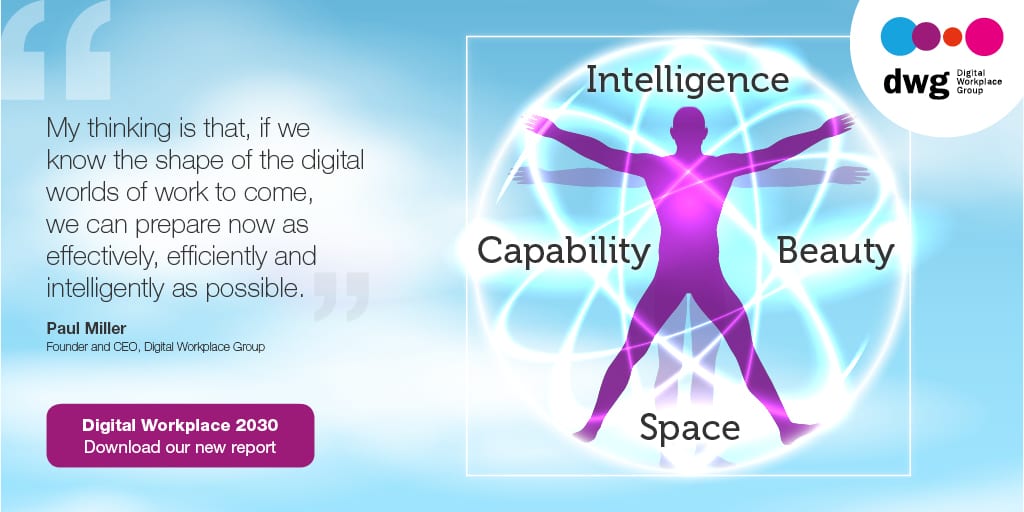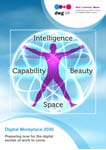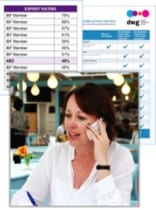Introducing the four dimensions of Digital Workplace 2030
 The practice of looking into the future and forming well-considered ideas about what we might find there requires of us both rigour and creativity. Organizations often use a 10-year timeframe for this process in order to stimulate creativity and suspend current operational thinking, while avoiding the process seeming too much like science fiction. So when setting out to explore the future of the digital workplace at DWG, Paul Miller and I selected the year 2030 as the anchor for our exploration of the future unfolding of the digital worlds of work.
The practice of looking into the future and forming well-considered ideas about what we might find there requires of us both rigour and creativity. Organizations often use a 10-year timeframe for this process in order to stimulate creativity and suspend current operational thinking, while avoiding the process seeming too much like science fiction. So when setting out to explore the future of the digital workplace at DWG, Paul Miller and I selected the year 2030 as the anchor for our exploration of the future unfolding of the digital worlds of work.
Looking forward, looking backward and trendwatching
Looking forward means first looking backward in order to understand the path of technological progress already beaten, and what this means for what happens next. Doing so uncovered the fascinating work of a mathematician called Kondratiev and a phenomenon called K-waves that chart the leaps forward in technology that happen around every 40–60 years. An understanding of K-wave theory may seem a long way from the digital workplace, but what it shows us is why we are experiencing the present time as one of so much disruption – and what might come next. Crucially, this can help guide the strategies and business models we develop moving forward. And if that has captured your interest, you may want to go straight to the free report: Digital Workplace 2030: Preparing now for the digital worlds of work to come for the long read!
Looking forward requires us to take a good look around at the unfolding trends that will shape our uncertain future. Megatrends that will forge our 2030 world, as set out by Roland Berger, focus our attention on shifts such as changing demographics, globalization and future markets, scarcity of resources and climate change – as well as the nature of technology and innovation in a global knowledge society. Yet, even such apparently clear signals and signposts of our future world exist in a context of increasing volatility, uncertainty, complexity and ambiguity (VUCA). As National Intelligence Council chairman, Christopher Kojm, put it in the Council’s “Global Trends 2030” report: “We are at a critical juncture in human history, which could lead to widely contrasting futures.”
With some indicators drawn from this scene setting, we embarked on a journey of discovery of what digital worlds of work might look like in 10+ years time. With a nod to some of the ideas drawn from history in our 2015 book “The Digital Renaissance of Work”, we drew on ancient Vitruvian principles of balance and proportion in architecture, to propose a framework for thinking about Digital Workplace 2030 that has four key dimensions: space, capability, intelligence and beauty. This sets the tone for an exploration of the future of work that is first and foremost about human flourishing and how we inhabit the digital worlds of work we are already creating and others we have yet to create.
Based on these ideas, we focus in on four dimensions of the digital workplace in 2030:
Dimension 1: Space
Digital Workplace 2030 is characterized by its inclusiveness as it breaks down boundaries of organizations, teams and industries to enable digital and physical spaces for frictionless collaboration, creativity and innovation. Here we explore the reinvention of digital and physical space that has already started and will continue to progress as familiar boundaries – between physical and digital, organizations and teams, work and home, inside and outside of the organization – continue to shift and blend.
In a fascinating interview with Teem’s Ryan Anderson, he talks about “mixed presence” and “inclusive design” when describing a future vision in which physical spaces morph and flex to help seed collaboration, nurture culture and enable diversity.
Dimension 2: Capability
Digital Workplace 2030 is both immersive and pervasive, providing augmented workers and managers with on-demand capabilities tailored to their needs and preferences. Capabilities confined to only the most advanced digital workplaces in the early decades of the 21st century will become widespread in the 2020s and fundamentally reinvented by the early 2030s. A seamless suite of tools, including apps to support specific roles and jobs, dashboards that integrate business data into meaningful outputs, and chatbots using natural language processing, will all simplify interactions with information and people, thereby enabling work to happen more easily. The increasing capability and intelligence of the digital workplace will not only empower workers but also mean it does more of the work currently carried out by humans, leading to a reshaping of all job roles.
Wells Fargo’s Pete Fields, reflecting on this dimension with us, provides a timely reminder for us all to stay focused on simple solutions that make a real difference.
Dimension 3: Intelligence
Digital Workplace 2030 is the intelligence engine that powers a data-driven, fluid organization, shaping itself around the goals and needs of the market, the organization and its workforce. In this dimension, we take a look at how growing AI capabilities will drive trends such as smart enterprises with data-driven decision-making, a fluid workforce that reshapes itself as needs change, pervasive measurement and insight into all aspects of work and the workplace, hyper-personalized digital work environments, and data-driven behaviour change.
Against a backdrop of challenges, such as market turbulence, talent scarcity and environmental issues, the smart enterprise that can adapt and react quickly will be a necessity in the coming decades. The digital workplace will be not only a critical tool, but increasingly at the helm in enabling the organization’s responsiveness. Hyperscience’s Omar Divina, in a thought-provoking exploration of this dimension, points to the importance of allowing a process of adjustment as humans increasingly work more closely with technology and give over some control to it, as well as the uniqueness of human qualities and abilities in this future picture.
Dimension 4: Beauty
Digital Workplace 2030 is beautiful in its experience, ethical foundation and purpose of enabling human development, wellbeing and fulfilment at work. One of the core Vitruvian principles of architecture – beauty – encapsulates both the visual attractiveness and the “pleasurableness” of a building, and this holds equally true for digital environments.
The path to beautiful, pleasurable digital work environments is one already being beaten early on in the century by a band of pioneering user experience (UX) practitioners. But whereas currently they constantly run up against walls in organizations when senior management do not fully grasp the importance or value of UX, this will be well understood by 2030. Humans adapting to poorly designed workplace technology, with the associated cognitive load and friction, will shift progressively toward technology that adapts to humans. As we have already seen in previous dimensions, this will include new, more natural, ways of interacting with it, such as by looking, speaking and gesturing rather than clicking and typing. Adobe’s Dan Mullis focuses in on a future experience of the digital workplace that is seamless, transparent and frictionless – one that enables continuity across our working relationships, meetings and touchpoints.
This dimension also encapsulates the importance of digital workplaces that represent ethical, sustainable environments which support worker health, wellbeing and happiness. We explore ethical questions that digital workplace practitioners need to explore as new technologies and capabilities increasingly become a reality.
To take a deeper dive into the four dimensions, download the free report “Digital Workplace 2030: Preparing now for the digital worlds of work to come”. In the next post, we’ll explore what organizations need to think about and do now to prepare for the future digital world of work.
Find out how Digital Workplace Group can help your organization prepare for the future digital workplace with our Digital Workplace 2030 workshop, in which we will take participants on a journey of “futuring” and “visioning”. This challenging and thought-provoking session is designed to help digital workplace practitioners extend their thinking, identify potential future outcomes/opportunities/threats, develop a vision for the future and see how to move towards it.
Find out what’s in the library and new research that’s coming up. Please contact Nancy Goebel to discuss how to gain access to the library with DWG membership.
Digital workplace 2030
Arrange a call
Categorised in: Future of work, Research reports
 Download free report »
Download free report »
